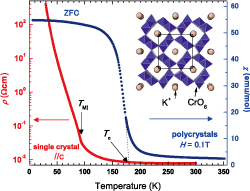Discovery of Novel Ferromagnetic Metal-Insulator Transition
Y. Ueda and Yagi Groups
Metal-insulator transition is one of the most drastic phenomena in strongly correlated electron systems. We found novel metal-insulator transitions in hollandites. Hollandite with a general chemical formula A2M8O16 is one of minerals. The crystal structure consists of the M8O16-framework and A-cations at tunnel sites in the M8O16-framework. The most popular crystal symmetry is a tetragonal I4/m in which the crystallographycally independent M site is unique, hence, K2M8O16 is a mixed valent oxide with M3+/M4+ = 1/3. K2M8O16 (M = Ti, V, Cr, Mn) have been prepared by high pressure synthesis. These compounds enable us to systematically study electron correlation effect as a function of filling level in the common band structure. K2Ti8O16 at a low filling level is a Pauli-paramagnetic metal [1]. On the other hand, K2V8O16 close to half-filling exhibits a metal-insulator transition accompanied by the charge ordering [2]. Very recently, we found a ferromagnetic metal-insulator transition in three-quarter-filled K2Cr8O16 [3]: K2Cr8O16 is a ferromagnetic metal with TC =180 K. The net magnetization of 17.7 μB/8Cr is very close to full moment of 18 μB/8Cr; {2Cr3+(d3) + 6Cr4+(d2)}. The Curie constant C = 8.1 (emu/Cr-mol)K (approximately 7 μB/Cr) estimated from Curie-Weiss fitting of magnetic susceptibility in the paramagnetic region is much larger than the calculated value of 1.19 (emu/Cr-mol)K (2.25 μB/Cr) from the averaged valence of Cr+3.75, which suggests strong ferromagnetic spin fluctuation. Surprisingly, this ferromagnetic metal transforms to an insulator at TMI = 95 K without any apparent structural change but retaining ferromagnetism.

Temperature dependences of resistivity (ρ) and magnetic susceptibility (χ) of K2Cr8O16. K2Cr8O16 is a ferromagnetic metal with TC = 180 K and shows a transition to an insulator at TMI = 95 K without any apparent structural change but retaining ferromagnetism. The crystal structure consists of Cr8O16-framework and K+-ions, as shown in the inset of Fig. 1. The Cr8O16-framework is constructed from the double-chains of edge-shared CrO6 octahedra that are corner-connected with other chain units. It is characteristic of a one-dimensional tunnel running parallel to the tetragonal c-axis and the tunnels are filled with K+.
K2Cr8O16 is quite unique in three aspects: It has a rare mixed valence of Cr3+ and Cr4+; it has a metal (or half-metal) to insulator transition in a ferromagnetic state; and the resulting low temperature phase is a rare case of a ferromagnetic insulator. This discovery could open a new frontier on the relation of magnetism and conductivity in strongly correlated electron systems.
References
- M. Isobe, S. Koishi, S. Yamazaki, J-I. Yamaura, H. Gotou, T. Yagi, and Y. Ueda, J. Phys. Soc. Jpn. 78, 114713 (2009).
- M. Isobe, S. Koishi, N. Kouno, J-I. Yamaura, T. Yamauchi, H. Ueda, H. Gotou, T. Yagi, and Y. Ueda, J. Phys. Soc. Jpn. 75, 073801 (2006).
- K. Hasegawa, M. Isobe, T. Yamauchi, H. Ueda, J-I. Yamaura, H. Gotou, T. Yagi, H. Sato, and Y. Ueda, Phys. Rev. Lett. 103, 146403 (2009).
